Place
| Kowloon 九龍 | |
|---|---|
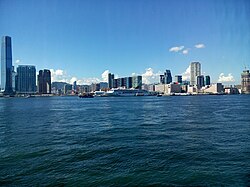 Kowloon as viewed from Hong Kong Island Kowloon as viewed from Hong Kong Island | |
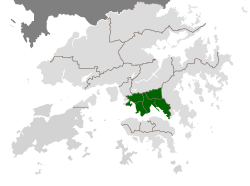 Location within Hong Kong (in green) Location within Hong Kong (in green) | |
| Area | |
| • Land | 67 km (26 sq mi) |
| Population | |
| • Total | 2,108,419 (2.1 million) |
| • Density | 43,033/km (111,450/sq mi) |
| Time zone | UTC+8 (Hong Kong Time) |
| Kowloon | |||||||||||||||||||||||||||
|---|---|---|---|---|---|---|---|---|---|---|---|---|---|---|---|---|---|---|---|---|---|---|---|---|---|---|---|
 "Kowloon" in Traditional (top) and Simplified (bottom) Chinese characters "Kowloon" in Traditional (top) and Simplified (bottom) Chinese characters | |||||||||||||||||||||||||||
| Traditional Chinese | 九龍 | ||||||||||||||||||||||||||
| Simplified Chinese | 九龙 | ||||||||||||||||||||||||||
| Jyutping | gau2 lung4 | ||||||||||||||||||||||||||
| Literal meaning | "Nine Dragons" | ||||||||||||||||||||||||||
| |||||||||||||||||||||||||||
Kowloon (/ˌkaʊˈluːn/) is an urban area in Hong Kong comprising the Kowloon Peninsula and New Kowloon. It has a population of 2,019,533 and a population density of 43,033/km (111,450/sq mi) in 2006. It is one of the three areas of Hong Kong, along with Hong Kong Island and the New Territories. It is the smallest, second most populous and most densely populated of the divisions.
Location
Kowloon is located directly north of Hong Kong Island across Victoria Harbour. It is bordered by the Lei Yue Mun strait to the east, Mei Foo Sun Chuen, Butterfly Valley and Stonecutter's Island to the west, a mountain range, including Tate's Cairn and Lion Rock to the north, and Victoria Harbour to the south.
Administration
Main articles: Kowloon Central, Kowloon East, and Kowloon WestKowloon comprises the following districts:
Name
The name 'Kowloon' (Chinese: 九龍; lit. 'nine dragons') alludes to eight mountains and a Chinese emperor: Kowloon Peak, Tung Shan, Tate's Cairn, Temple Hill, Unicorn Ridge, Lion Rock, Beacon Hill, Crow's Nest and Emperor Bing of Song. It was also spelt 'Kawloong' in some 19th-century sources.
History

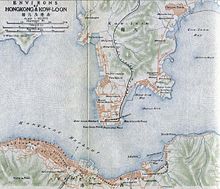

The part of Kowloon south of Boundary Street, together with Stonecutters Island, was ceded by Qing China to the United Kingdom under the Convention of Peking of 1860. For many years the area remained largely undeveloped, used by the British mainly for tiger-hunting expeditions. The part of Kowloon north of Boundary Street (New Kowloon) was leased by the British as part of the New Territories under the 1898 Second Convention of Peking for 99 years. Within New Kowloon is Kowloon City, an area of Hong Kong where the Kowloon Walled City used to be located. The Kowloon Walled City itself was demolished in 1993. The same area was called Kwun Fu Cheung (官富場) during the Song dynasty (960–1279). "New Kowloon" has remained part of the New Territories.
Statutorily, "Kowloon" is only the area south of Boundary Street and Stonecutters Island, but in common use, New Kowloon is not regarded as part of the New Territories, but as an integral part of the Kowloon urban area whether north or south of Boundary Street.
Large-scale development of Kowloon began in the early 20th century, with the construction of the Kowloon-Canton Railway and the Kowloon Wharf, but because of the close proximity of Kowloon's built-up area to Kai Tak Airport, building construction was limited by flight paths. As a result, compared to Hong Kong Island, Kowloon had a much lower skyline. After World War II, Kowloon became extremely congested when slums for refugees from the newly established People's Republic of China gave way to public housing estates, mixed with private residential, commercial, and industrial areas.
The area of reclaimed land now known as West Kowloon was once home to a dockyard for the Royal Navy.
The 1911 census recorded a population of 7,306, with most being Hakka. The invasion of China by Japan in 1937 caused the population of Kowloon to grow drastically. Between 1937 and 1939, 750,000 refugees arrived in Kowloon and nearby areas, with many not having residence.
Demographics
As of 2011, 2,108,419 people lived in Kowloon.
About 94.2% of Kowloon's residents are of Han Chinese ethnicity. The largest ethnic minority groups are Indonesians (1.8%), Filipinos (1.5%), Indians (0.5%), Nepalese (0.4%), and British (0.3%). Around 86% of Kowloon's residents use Cantonese as their usual language, while 2.3% use English and 1.2% use Mandarin.
Localities
Kowloon comprises these localities of Hong Kong:
- Anderson Road area
- Austin
- Cha Kwo Ling
- Cheung Sha Wan
- Diamond Hill
- Jordan
- Hammer Hill
- Hung Hom
- Ho Man Tin
- Kai Tak
- Kowloon Bay
- Kowloon City
- Kowloon Tong
- Kwun Tong
- Lai Chi Kok
- Lam Tin
- Lei Yue Mun
- Ma Tau Wai
- Mong Kok
- Ngau Chi Wan
- Ngau Tau Kok
- Prince Edward
- San Po Kong
- Sau Mau Ping
- Sham Shui Po
- Shek Kip Mei
- Tai Kok Tsui
- To Kwa Wan
- Tsim Sha Tsui
- Tsz Wan Shan
- West Kowloon
- Wong Tai Sin
- Yau Ma Tei
- Yau Tong
Education


Lists of primary and secondary schools in Kowloon by district:
- List of schools in Kowloon City District
- List of schools in Kwun Tong District
- List of schools in Sham Shui Po District
- List of schools in Wong Tai Sin District
- List of schools in Yau Tsim Mong District
Tertiary education
- City University of Hong Kong
- Hong Kong Polytechnic University
- Hong Kong Baptist University
- Open University of Hong Kong
- Tung Wah College
- Hong Kong Nang Yan College of Higher Education
- Gratia Christian College
Notable people
- Sean Parry (born 1987), cricketer
- Jackson Wang (born 1994), musician
Transport

Kowloon is connected to Hong Kong Island by two road-only tunnels (the Cross-Harbour Tunnel and the Western Harbour Crossing), three MTR railway tunnels (Tsuen Wan line, Tung Chung line/Airport Express and East Rail) and one combined road and MTR rail link tunnel (Eastern Harbour Tunnel, containing the Tseung Kwan O line and road traffic in separate parallel conduits). No bridges connect the island and Kowloon.
Gallery
| This section contains an unencyclopedic or excessive gallery of images. Please help improve the section by removing excessive or indiscriminate images or by moving relevant images beside adjacent text, in accordance with the Manual of Style on use of images. (June 2019) (Learn how and when to remove this message) |
-
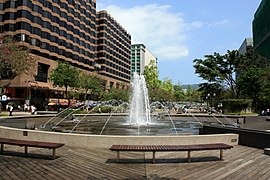 Urban Council Centenary Garden fountain, Tsim Sha Tsui
Urban Council Centenary Garden fountain, Tsim Sha Tsui
-
Maze Garden, Kowloon Park, Tsim Sha Tsui
-
 An Air France Boeing 747 passing above Kowloon, prior to landing at the old airport in 1998.
An Air France Boeing 747 passing above Kowloon, prior to landing at the old airport in 1998.
-
 Star Ferry Pier, with the Hong Kong Cultural Centre and Tsim Sha Tsui Clock Tower in the background.
Star Ferry Pier, with the Hong Kong Cultural Centre and Tsim Sha Tsui Clock Tower in the background.
-
 Kowloon Masjid and Islamic Centre
Kowloon Masjid and Islamic Centre
-
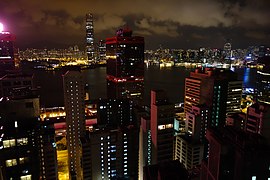 Night view of Kowloon from Hong Kong Island
Night view of Kowloon from Hong Kong Island
 Kowloon Peninsula panorama
Kowloon Peninsula panorama
References
- ^ Fallon, Steve. (2006) Hong Kong and Macau. Lonely Planet Publishing. ISBN 981-258-246-0
- "KAWLOONG FERRY STATION: Hong Kong postcard (C48147)". eBay. Archived from the original on 12 November 2022. Retrieved 27 February 2022.
- 10,000 Chinese Numbers. Lulu.com. p. 207. ISBN 9780557006212. Archived from the original on 23 August 2016.
- James Hayes, The Hong Kong Region 1850–1911. Hong Kong, 2012. ISBN 9888139118
- "Hong Kong 2003 – History". www.yearbook.gov.hk. Archived from the original on 26 September 2011. Retrieved 28 April 2018.
- ^ District Profiles, Hong Kong Census, 2011, archived from the original on 27 September 2013, retrieved 27 September 2013
External links
 Media related to Kowloon at Wikimedia Commons
Media related to Kowloon at Wikimedia Commons Media related to Kowloon West at Wikimedia Commons
Media related to Kowloon West at Wikimedia Commons
| Hong Kong Island | |
|---|---|
| Kowloon and New Kowloon | |
| New Territories (excluding New Kowloon) | |
| Urban areas of Hong Kong, Kowloon and New Territories | |||||||||||
|---|---|---|---|---|---|---|---|---|---|---|---|
| Hong Kong |
|  | |||||||||
| Kowloon |
| ||||||||||
| New Kowloon |
| ||||||||||
| New Territories |
| ||||||||||
| Official place names are summarized from "Geoinfo Map" of Government of Hong Kong Special Administrative Region, "Hong Kong Guide" of Lands Department, "Hong Kong Guide Book" of Universal Publications Ltd. and "Areas and Districts" of Rating and Valuation Department. M:Narrow meaning of urban areas KL: Kowloon Peninsula at the south of Boundary Street NKL: Former New Territories area at the north of Boundary Street and at the south of Lion Rock 1: Common definition (1) 2: Common definition (2) 3: Common definition (3) 4: Areas not adopting small house concessionary right of indigenous inhabitants 5: Jurisdiction area of former Urban Council 6: Definition of "Metropolitan Area" of Planning Department 7: Jurisdiction area of Urban Renewal Authority 8: Unique operating area of urban taxis 9: "Urban" (9a) and "Extended Urban" (9b) areas defined by Hong Kong Housing Authority 10: Definition of Urban rates 11: Hospital cluster belongs to Hong Kong or Kowloon 12: Police region belongs to Hong Kong or Kowloon 13: Regions having 999-year land lease 14: Geographical Constituency in Hong Kong Legislative Council belongs to Hong Kong or Kowloon 15: Regional Education Office belongs to Hong Kong or Kowloon 16: Primary One Admission School Net belongs to Hong Kong or Kowloon | |||||||||||
22°19′N 114°11′E / 22.317°N 114.183°E / 22.317; 114.183
Categories: